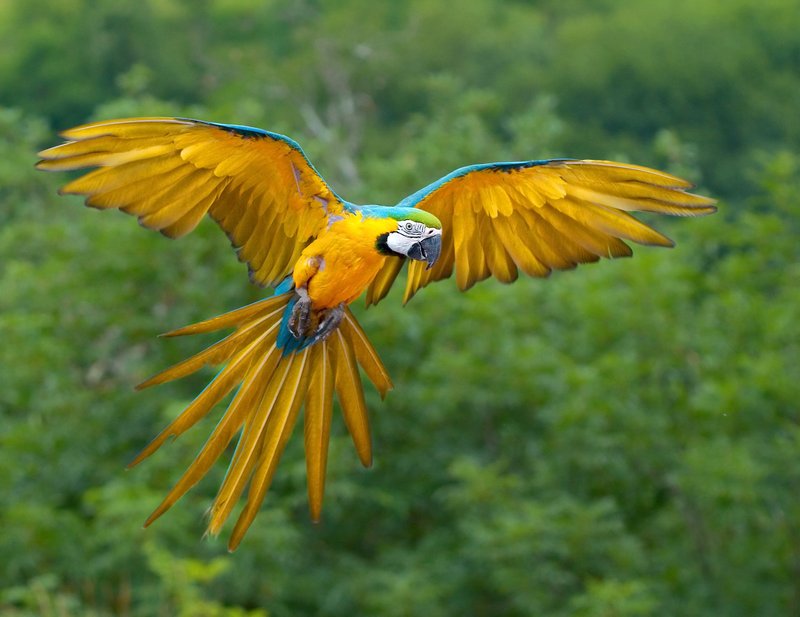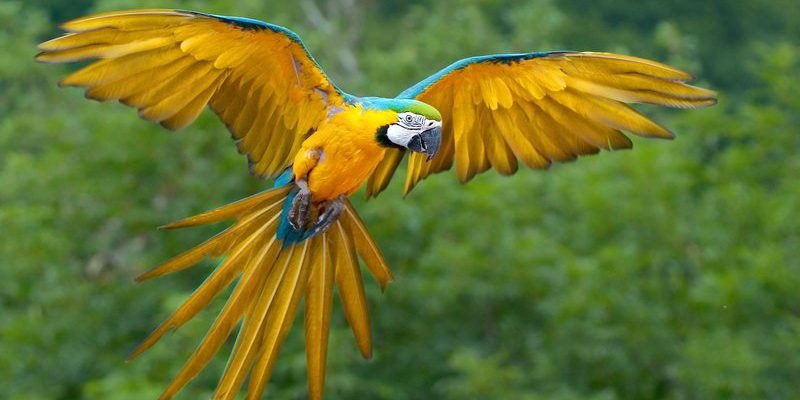
The Blue-and-Yellow Macaw, scientifically known as *Ara ararauna*, is native to a variety of habitats across Central and South America. Imagine lush green forests, vast grasslands, and even mangroves—these birds thrive in all these environments. Let’s take a deeper dive into where you can find them around the globe, what kind of habitats they prefer, and what makes their living situations so unique.
Natural Habitats of Blue-and-Yellow Macaws
When we talk about the habitats of Blue-and-Yellow Macaws, we’re looking at a range of environments where they feel right at home. These charming birds primarily exist in tropical rainforests, but they’re also flexible. You can find them in savannas, forest edges, and sometimes even in semi-arid regions where thick trees are present.
Here’s the thing: tropical rainforests are their favorite haunts. With towering trees and rich biodiversity, these areas provide plenty of food and nesting opportunities. Blue-and-Yellow Macaws typically prefer habitats like the Amazon Basin, where they can roam freely and find their go-to food sources like seeds, nuts, and fruits.
Here’s a quick overview of their natural habitat preferences:
- Tropical Rainforests: Dense vegetation with plenty of food.
- Wooded Savannas: Open spaces to fly and forage.
- Forest Edges: Preferred nesting spots near food sources.
- Coastal Mangroves: Lesser-known but still suitable habitats.
The versatility of the Blue-and-Yellow Macaw’s habitat allows them to adapt to various environments. However, their survival hinges on the preservation of these crucial ecosystems.
The Range of Blue-and-Yellow Macaws
Now let’s explore the geographical range of the Blue-and-Yellow Macaw. Their territory isn’t just a dot on a map; it’s a wide expanse stretching from the tropical regions of Central America to the lush forests of South America. You’ll find them in areas from the eastern part of Panama down to the northern regions of Argentina and Paraguay.
In South America, they’re commonly spotted in countries like Brazil, Bolivia, and Peru. The Amazon rainforest is a prime spot, offering them a lush habitat filled with everything they need. You might even catch a glimpse of them soaring through the vibrant green canopies, their bright colors contrasting beautifully against the deep greens.
In Central America, they favor the lowland forests and coastal areas of countries like Costa Rica and Honduras. They tend to be more concentrated in some areas, especially where food sources are abundant.
Best Places to Spot Blue-and-Yellow Macaws
If you’re itching to see Blue-and-Yellow Macaws in their natural habitat, certain regions stand out. Some specific locations are known for their thriving populations of these beautiful birds.
The Amazon Rainforest is a top contender. Countries like Brazil and Peru have eco-tours that let you explore the depths of the rainforest, and you might just spot a Blue-and-Yellow Macaw flying overhead or perched on a branch.
Then there’s the Pantanal in Brazil, which is the world’s largest tropical wetland. This unique ecosystem is teeming with wildlife, making it an ideal spot for birdwatchers. Blue-and-Yellow Macaws are often seen here, especially along the rivers.
Another fantastic location is Manuel Antonio National Park in Costa Rica. Known for its rich biodiversity, this national park is a hotspot for various bird species, including our lively Blue-and-Yellow Macaws.
Lastly, Iguazu National Park on the border of Brazil and Argentina provides breathtaking views and a chance to catch these birds in action.
What Attracts Blue-and-Yellow Macaws to These Areas?
You might be wondering why Blue-and-Yellow Macaws are drawn to these specific habitats. Well, it all comes down to their diet and nesting preferences. These birds are primarily seed eaters, and their beaks are perfectly designed for cracking open tough nuts.
In areas where fruit trees and nut-bearing plants are abundant, like in tropical rainforests, macaws can find plenty to munch on. They’re also big fans of palm trees, which provide nesting sites and food.
The availability of clean water sources is another critical factor. Macaws need to stay hydrated, especially in hot climates. These water sources not only nourish them but also attract other wildlife, creating a thriving ecosystem where macaws can thrive.
Conservation Status and Threats
Despite their beauty, Blue-and-Yellow Macaws face threats that endanger their populations. Habitat loss due to logging, agriculture, and urban expansion is a significant concern. As forests are cleared, these birds lose their homes and food sources.
Another pressing issue is illegal trapping for the pet trade. Macaws are popular pets due to their striking colors and lively personalities, leading to unsustainable hunting practices.
Conservation efforts are ongoing, with several organizations working to protect their habitats. Initiatives like reforestation and legal protections are essential to preserving the environments these birds rely on. Supporting these efforts through eco-friendly tourism can make a big difference.
How to Be a Responsible Birdwatcher
If you’re planning to go birdwatching to see Blue-and-Yellow Macaws, being responsible is crucial. Here are a few tips to ensure your adventures help rather than harm these magnificent creatures:
- Keep Your Distance: Avoid getting too close to nesting sites. Use binoculars to enjoy the view without disturbing them.
- Follow Local Guidelines: Respect the rules set by parks and reserves. They’re in place to protect wildlife.
- Don’t Feed Wild Birds: Feeding them can disrupt their natural foraging behavior and diet.
- Support Eco-Friendly Tours: Choose tours that are committed to conservation efforts.
Being a responsible birdwatcher can contribute to the preservation of the habitats that Blue-and-Yellow Macaws depend on.
Spotting a Blue-and-Yellow Macaw in the wild is like finding a piece of nature’s art. From the Amazon Rainforest to the Pantanal, these vibrant birds bring life to their habitats. Understanding where to find them, what attracts them, and the conservation challenges they face allows us to appreciate them even more.
So, if you’re lucky enough to visit their habitats, remember to enjoy the view while being respectful of the beautiful environment around you. After all, the world is a richer place with these colorful characters flying about.

